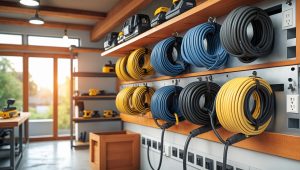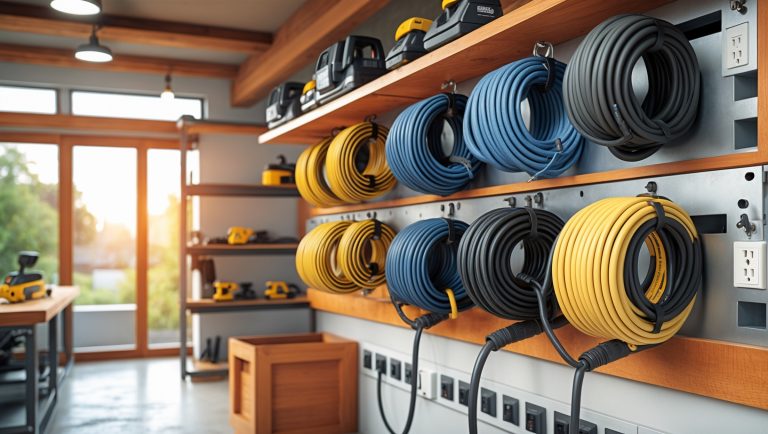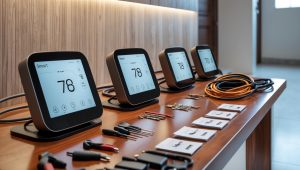Introduction: Why Compliance and Permits Matter for DIY Home Projects
When you’re eager to tackle repairs, maintenance, or upgrades around your home, it’s tempting to focus on the excitement of new tools and the satisfaction of a job well done. But before you break out your drill or install that sleek new gadget, there’s a critical step that too many DIYers overlook: understanding compliance regulations and permits. Navigating these requirements isn’t just about ticking bureaucratic boxes. It’s about protecting your investment, ensuring safety, and avoiding hefty fines or do-overs that can derail even the best-planned home projects.
From electrical upgrades to backyard sheds, many common home tasks are subject to local and state codes. Permits and compliance rules govern the tools you use, the methods you follow, and sometimes even the brands of equipment allowed for specific applications. Ignoring these guidelines can result in failed inspections, insurance claim rejections, or unsafe installations that risk your home and family. In this guide, we’ll break down what you need to know about permits, compliance documentation, and how to equip yourself for a smooth, stress-free DIY experience. Whether you’re hanging a ceiling fan, installing smart home devices, or building a deck, you’ll learn how to identify regulations, streamline approvals, and ensure your tools are up to code—so your next project is legal, safe, and built to last.
Understanding Compliance: The Basics for Home DIYers
What is Compliance in the Context of Home Projects?
Compliance refers to following all applicable laws, codes, and standards that govern construction, repairs, upgrades, and maintenance in residential settings. This covers:
- Building Codes: Set minimum safety standards for structures, electrical systems, plumbing, and more.
- Tool and Equipment Standards: Tools must often be certified (UL, CE, CSA, etc.) for safety and suitability.
- Environmental Regulations: Rules about hazardous materials (e.g., lead paint, asbestos), disposal, and energy efficiency.
- Homeowners’ Association (HOA) Rules: Additional guidelines specific to certain neighborhoods or developments.
Why Compliance is Critical
- Safety: Codes are designed to protect occupants and property from hazards.
- Legal Requirements: Failure to comply can lead to fines, stop-work orders, or forced removal of improvements.
- Insurance: Non-compliant work may void homeowner’s policies or lead to denied claims.
- Resale Value: Unpermitted or non-compliant work can lower home value or complicate sales.
Permits: When Are They Required?
Common Home Projects That Require Permits
- Electrical Upgrades: Adding outlets, rewiring, new circuits, installing a generator.
- Plumbing Work: Replacing water heaters, moving fixtures, installing new lines.
- Structural Changes: Removing or adding walls, enlarging windows, building additions or decks.
- Major Appliance Installation: HVAC systems, gas stoves, fireplaces.
- Exterior Projects: Fences, sheds, roofing, driveways, pools.
Some minor repairs (painting, replacing faucets, minor flooring) typically don’t require permits, but always check with your local authority.
Who Issues Permits and How?
Permits are usually issued by your city or county building department. The application process can range from an online form to an in-person visit with detailed plans. Expect to submit:
- Project description and location
- Diagrams or blueprints
- List of tools and equipment to be used
- Proof of compliance with safety standards
Fees vary widely, so budget accordingly. Some jurisdictions offer expedited permits for simple projects, while others may require detailed inspections at different phases.
Tools, Equipment, and Compliance: What You Need to Know
Are Your Tools Legal and Up to Code?
It’s not just your project that must comply—your tools and equipment matter too. Issues to watch for include:
- Certification: Power tools and electrical gadgets should have recognized safety certifications (e.g., UL for the U.S., CE for Europe).
- Voltage and Compatibility: Using tools rated for the wrong voltage can be a code violation and a hazard.
- Condition: Damaged cords, missing guards, or altered safety features can fail inspection and risk injury.
- Proper Use: Some projects require specific tools (e.g., GFCI testers for electrical work) to pass inspection.
Documentation You Should Keep
- Receipts and manuals for tools and equipment
- Proof of certification or compliance (labels, product sheets)
- Inspection records (if applicable)
This paperwork may be required to obtain permits or pass final inspections, especially for major appliances and systems.
Step-by-Step: Navigating the Permit Process
Step 1: Research Local Requirements
Visit your city or county’s building department website. Look for:
- Permit requirements by project type
- Downloadable application forms
- Fee schedules
- Inspection checklists
Call or email if information is unclear—staff can clarify gray areas and suggest best practices for DIYers.
Step 2: Prepare Your Application
- Draw plans if needed (many departments offer templates)
- List all tools and equipment you’ll use
- Gather compliance documentation for major gear
- Estimate project start and completion dates
Be thorough—missing information leads to delays.
Step 3: Submit and Pay Fees
Submit your application online or in person. Some areas offer same-day approval for simple projects, while others may take weeks. Be prepared to pay fees, which can range from $20 (simple electrical) to several hundred for structural work.
Step 4: Schedule Inspections
Most permits require at least one inspection. Common checkpoints:
- Rough-in (before walls are closed)
- Final (after everything is complete)
- Specialty (e.g., electrical, plumbing, gas, energy efficiency)
Keep your work area clean and all compliance documentation handy. Inspectors may ask to see tool certifications or proof of purchase for critical equipment.
Step 5: Approval and Recordkeeping
Once approved, keep copies of all permits and inspection reports. You may need these for insurance, future upgrades, or when selling your home.
Special Considerations: Smart Home Gadgets and New Tech
Permits for Smart Devices
Many homeowners assume that installing smart thermostats, security systems, or lighting controls doesn’t require permits. While some plug-and-play devices are exempt, any project that involves wiring, integration with major systems (HVAC, electrical panels), or structural changes will likely trigger permitting requirements.
Some jurisdictions also require that smart devices meet specific energy efficiency or communication standards. Always check compatibility and certification before purchase.
DIY Installation vs. Professional Help
- DIY: Allowed for most projects if you own the home and follow all codes. Some complex jobs (natural gas, high-voltage wiring) may require licensed contractors.
- Pro: Hiring a licensed pro can simplify permitting and compliance, as they handle paperwork and inspections.
Be honest about your skill level, and don’t be afraid to call in a professional for critical tasks.
Cost Breakdown: Budgeting for Permits and Compliance
Typical Permit Costs
- Minor electrical/plumbing: $20–$100
- Major remodels/additions: $200–$1,500
- Accessory structures (sheds, decks): $50–$500
Some regions charge based on project value or square footage. Always include these costs in your project budget.
Hidden Compliance Expenses
- Upgrading tools (GFCI outlets, certified testers)
- Additional safety equipment (fire extinguishers, shut-off valves)
- Professional plan reviews or engineering reports
- Re-inspection fees if you fail the first time
Plan for contingencies; a little extra set aside can prevent costly surprises.
Best Practices: Staying Compliant and Stress-Free
- Double-Check Before You Start: When in doubt, ask your local building department.
- Maintain a Compliance Binder: Store all permits, receipts, and tool documentation in one place.
- Stay Up-to-Date: Codes change—review requirements before every new project.
- Respect Inspection Schedules: Don’t skip or delay required inspections.
- Upgrade Tools as Needed: Outdated or uncertified tools can hold up approval or endanger your project.
Case Studies: Compliance in Action
Case 1: The Unpermitted Electrical Upgrade
Sarah, a DIY enthusiast, rewired her garage without a permit using uncertified extension cords. An electrical fire broke out months later, and her insurance claim was denied due to unpermitted and non-compliant work. The lesson: permits and proper tools aren’t red tape—they’re essential protection.
Case 2: Smooth Sailing with Smart Planning
Mike wanted to build a backyard shed. He researched local permit rules, submitted clear plans, bought only certified tools, and scheduled inspections as required. The project passed with flying colors, and Mike’s resale value increased. Preparation and compliance saved time, money, and stress.
Conclusion: Make Compliance and Permits Your DIY Foundation
Every successful DIY home project rests on more than skill, passion, and the right tools. It demands a solid understanding of compliance and permitting—the invisible framework that keeps your work legal, safe, and insurable. While navigating local codes, paperwork, and inspections might seem daunting at first, it’s a small investment compared to the potential risks of skipping these steps. Unpermitted or non-compliant work can lead to expensive fines, unsafe conditions, insurance nightmares, and headaches when you try to sell your home down the line.
By taking the time to research your local requirements, using certified tools and equipment, and keeping meticulous records, you transform your DIY experience from a potential liability into a source of pride and lasting value. Think of compliance not as an obstacle but as a safety net—and a tool in its own right. It ensures that every improvement you make stands up to scrutiny, protects your family, and boosts your confidence as a home improver.
So next time inspiration strikes, add one more item to your project checklist: permits and compliance. It’s the smart, responsible, and ultimately rewarding way to make your house a better home—one code-approved project at a time.











I see you mentioned that some permits and codes even specify which brands or types of equipment are allowed. How do homeowners typically find out if a specific tool or device brand is compliant with their local regulations before making a purchase?
Homeowners usually start by checking with their city or county building department, as they can provide details on approved brands or equipment types. Another good step is to review official permit application forms or local building codes, which sometimes list specific requirements. For major appliances or electrical tools, looking for UL or other certification labels can also help ensure compliance.
I noticed the article mentions that some tools need to be certified, like UL or CE. Is it required by law to use only certified tools for all home improvement projects, or are there exceptions for basic repairs and smaller DIY tasks?
Not all home improvement projects legally require you to use certified tools. Certification like UL or CE is most often required for tools that are sold commercially or used in professional settings. For basic repairs and small DIY tasks at home, there’s generally no legal requirement, but using certified tools is still safer. Always check local codes, especially for electrical work, as some areas do have stricter rules.
If I’m just installing some smart home devices like thermostats and door cameras, do I really need to worry about pulling permits or do those kinds of upgrades usually fly under the radar of compliance rules?
For most smart home upgrades like thermostats and door cameras, you typically don’t need permits, especially if you’re not making changes to your home’s wiring or structure. Simple plug-and-play or battery-operated devices usually aren’t regulated. However, if your installation involves electrical work or hardwiring, some local codes may require a permit. It’s always best to check with your local building department to be sure.
I noticed you mentioned that even basic projects like hanging a ceiling fan might require permits and compliance checks. Could you clarify which types of minor home upgrades typically fall under these regulations, and which might be exempt?
Minor upgrades like repainting walls, replacing carpets, or installing shelves usually do not require permits. However, tasks that involve electrical, plumbing, or structural changes—such as installing or moving a ceiling fan, adding outlets, or knocking down walls—often do. Local regulations vary, so it’s always wise to check with your local building department before starting any project involving wiring or pipes.
You mentioned that ignoring compliance guidelines can impact insurance claims. If I used a tool that isn’t officially certified but everything works fine, could my home insurance actually deny a claim if something goes wrong later?
Yes, your home insurance claim could be denied if an incident is linked to the use of a non-certified tool, even if it seemed safe at the time. Insurance providers often require compliance with safety standards and codes. If an investigation finds that uncertified equipment contributed to damage or injury, coverage might be reduced or refused. It’s always safest to use tools that meet all certification and compliance requirements.
When it comes to projects like building a backyard shed, are there major differences in permit requirements or tool regulations between states or even local areas? How should I start researching those differences before buying materials?
Permit requirements and tool regulations can vary significantly not just between states, but also between cities and counties. Some areas may require permits for almost any structure, while others are more lenient. Start by checking your local city or county government website for building codes and permit information. You can also call the local permitting office directly. It’s wise to do this research before buying materials to avoid any unexpected issues or costs.
If I’m planning to build a backyard shed as a weekend project, do I need to worry about tool standards and equipment certifications, or is that mainly an issue for bigger renovations like decks and major electrical work?
For a backyard shed project, tool standards and equipment certifications aren’t usually a concern for homeowners, as long as you’re using tools as intended and following basic safety guidelines. The main focus should be on getting the right permits and meeting building codes for your shed. Tool regulations are more relevant for contractors or for specialized work like major electrical jobs.
I’m trying to install a ceiling fan myself, but I’m a bit lost about which permits are actually needed for electrical upgrades in a typical suburban home. Can you explain how I figure out whether I need a permit just to swap a light fixture for a ceiling fan?
To determine if you need a permit for replacing a light fixture with a ceiling fan, check your local city or county building department’s rules. In many suburban areas, simple fixture swaps don’t need a permit, but anything involving new wiring or outlet changes usually does. Call or visit your local permit office, describe your project, and they’ll confirm if a permit is necessary for your situation.
If a DIYer starts work before realizing a permit is needed, what is the usual process to get back on track with compliance, and can any mistakes be corrected without significant penalties or having to redo the entire project?
If a DIYer discovers mid-project that a permit was required, the best step is to stop work and contact the local permitting office right away. Many municipalities allow retroactive permits, though inspections may be needed to check any completed work. Corrections might be required if something doesn’t meet code, but penalties are often less severe if you’re proactive and honest. Redoing the whole project is rare unless there’s a serious safety issue.
If I’m planning to install smart home devices myself, what’s the process for finding out the right compliance documentation or permits before starting, and does this usually delay the project by much?
To find out which compliance documents or permits you need for smart home device installation, contact your local building department or city permitting office. They can tell you if permits are required and what codes apply. Most small-scale, plug-and-play devices don’t need permits, but hardwired systems might. If a permit is required, it can add a few days to a couple of weeks, depending on your area’s process, but many projects move ahead smoothly when you check first.
The article mentions that some local codes specify which brands of equipment are acceptable for certain home projects. How can I find out if my city or county has a list of approved brands or tools before I buy anything?
To find out if your city or county has a list of approved brands or tools, start by checking your local building department’s website or calling them directly. You can also visit their office in person. They often provide guidelines, approved lists, or can direct you to the right resources. If your area has an online permitting portal, it may also include this information.
I’m just getting started with DIY and it looks like I might need to get certain permits before using some equipment. Can you explain the step-by-step process for figuring out which permits I actually need for different kinds of small home projects?
To figure out which permits you need, start by listing your planned projects and the tools or equipment involved. Next, check your city or county website for permit guidelines—most provide charts or FAQs for common DIY tasks. If you’re unsure, call your local permit office with details about your project. Always confirm before starting, since requirements can vary for electrical, plumbing, or structural work, even on small projects.
I get that permits are important, but how much of a delay should I expect when waiting for approvals? I usually have to squeeze projects into a weekend, so I’m worried about running into unexpected holdups.
Permit approval times can vary a lot depending on your location and the type of project. For simple home projects, permits may be approved within a few days, but in some areas or for more complex work, it could take a couple of weeks. It’s a good idea to contact your local permitting office ahead of time to ask about typical turnaround times so you can plan your weekends more accurately.
The article mentions that some projects require tools that are certified like UL or CE. How can I check if my existing tools meet those standards, and what should I do if they don’t? Is it risky to use uncertified tools for small repairs?
To check if your tools are UL or CE certified, look for certification markings on the tool’s label, packaging, or user manual. If you can’t find these marks, your tools might not be certified. Using uncertified tools, even for small repairs, can be risky as they may not meet safety standards. For your safety and compliance, consider replacing uncertified tools or using them only for non-critical tasks where risk is minimal.
For smaller DIY projects like hanging a ceiling fan or installing smart home devices, are there usually separate permit requirements, or do those typically fall under general home improvement regulations? I’m hoping to avoid unnecessary paperwork for minor upgrades.
For most smaller DIY projects like hanging a ceiling fan or installing smart home devices, separate permits are rarely required, as these usually fall under general home improvement regulations. However, if electrical wiring modifications are involved, some localities may require a permit. It’s wise to check with your local building department to confirm, but minor upgrades typically don’t trigger extra paperwork.
You mentioned that some projects, like building a shed or installing a deck, are subject to specific local and state codes. How can homeowners easily find out which permits they actually need before starting these kinds of projects?
To figure out which permits you need, start by visiting your city or county building department—most have websites with permit guides and contact details. You can also call or visit in person to explain your project. Staff there can quickly tell you about required permits and any specific codes. Double-checking with your local authority before starting helps avoid delays or fines.
You mentioned insurance claim rejections if projects aren’t up to code. If something goes wrong but I thought I followed the right permit process, what should I do to prove I was compliant and protect my investment?
If something goes wrong, keep all documentation related to your permit application and approvals, including emails, receipts, and inspection reports. Take photos during each stage of the project to show code compliance. If you ever face an insurance claim, this evidence can demonstrate you followed the correct process and help support your case.
I’m planning to put up a backyard shed this summer, but I’m confused about whether certain power tools I use also need to meet specific certifications, or if the focus is just on the structure itself. Can you clarify how tool standards factor into the permit process for projects like this?
When it comes to building a backyard shed, permits and inspections typically focus on the shed itself—its location, size, materials, and overall safety. The tools you use generally don’t need to meet specific certifications for permit approval, as long as they’re standard, commercially available equipment. However, if your local regulations have unique requirements for electrical or gas-powered tools, it’s a good idea to double-check with your permit office to be sure.